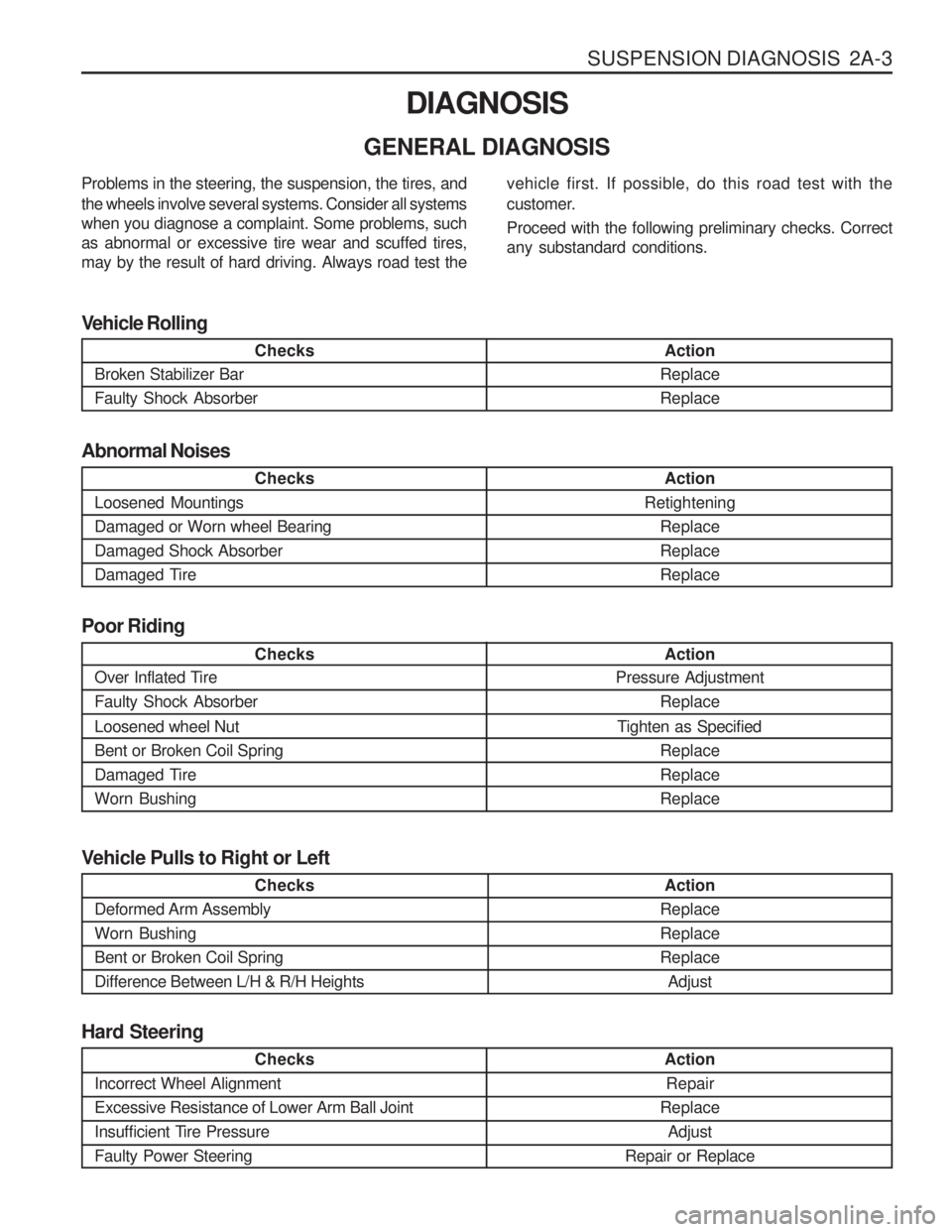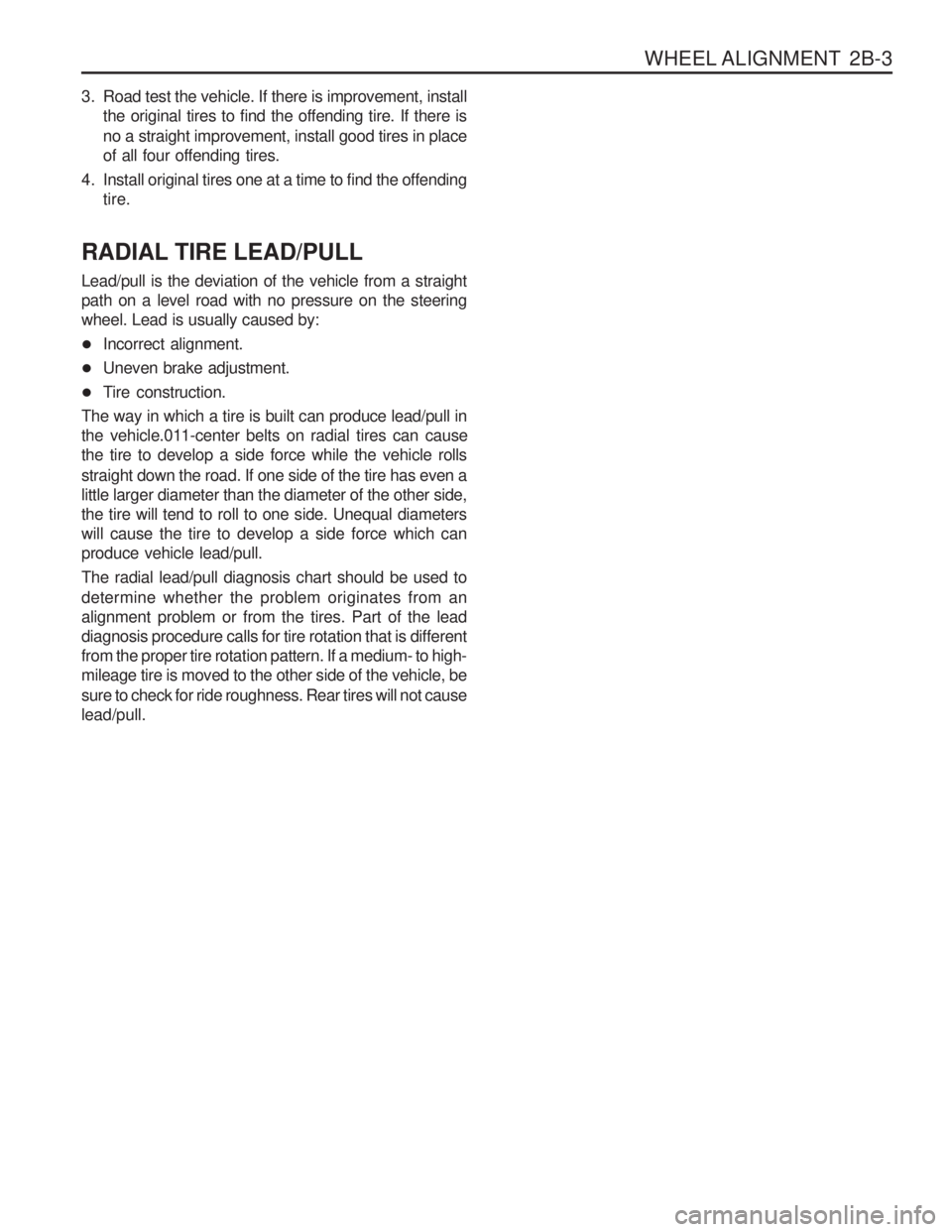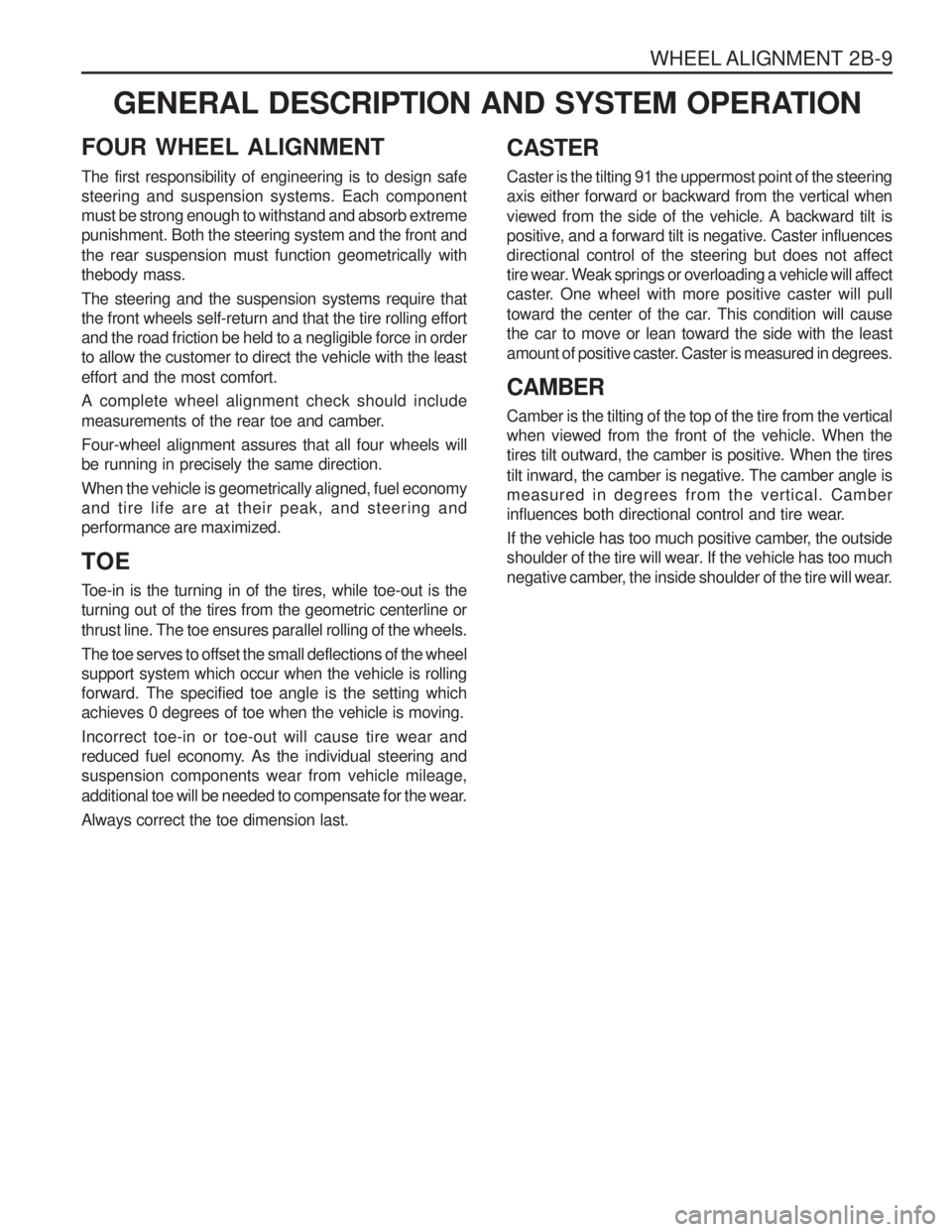Page 334 of 1574
OM600 ENGINE MECHANICAL 1B3-69
10. Install the fuel filter.
11. Install the vacuum pump.
12. Install the power steering pump.
13. Install the power steering pump pulley.
Tightening Torque 25 Nm
Tightening Torque 10 Nm
Tightening Torque 23 Nm
Tightening Torque 32 Nm
14. Install the guide pulley bracket.
Tightening Torque 9 Nm
Page 700 of 1574

SUSPENSION DIAGNOSIS 2A-3
DIAGNOSIS
GENERAL DIAGNOSIS
Checks
Loosened Mountings Damaged or Worn wheel BearingDamaged Shock Absorber
Damaged Tire Action
Retightening ReplaceReplaceReplace
Abnormal Noises
Checks
Broken Stabilizer Bar Faulty Shock Absorber Action
ReplaceReplace
Vehicle Rolling
Checks
Over Inflated Tire Faulty Shock Absorber Loosened wheel Nut Bent or Broken Coil Spring
Damaged TireWorn Bushing Action
Pressure Adjustment
Replace
Tighten as Specified ReplaceReplaceReplace
Poor Riding
Problems in the steering, the suspension, the tires, and the wheels involve several systems. Consider all systems when you diagnose a complaint. Some problems, suchas abnormal or excessive tire wear and scuffed tires,may by the result of hard driving. Always road test the
vehicle first. If possible, do this road test with the
customer. Proceed with the following preliminary checks. Correct any substandard conditions.
Checks
Incorrect Wheel Alignment Excessive Resistance of Lower Arm Ball Joint
Insufficient Tire PressureFaulty Power Steering
Action Repair
Replace Adjust
Repair or Replace
Hard Steering
Checks
Deformed Arm Assembly Worn BushingBent or Broken Coil SpringDifference Between L/H & R/H Heights Action
ReplaceReplaceReplace Adjust
Vehicle Pulls to Right or Left
Page 701 of 1574
2A-4 SUSPENSION DIAGNOSISChecks
Worn or Broken Coil Spring Checks
Incorrect Front wheel Alignment Worn or Loosened Lower Arm Bushing
Action
Replace
Repair or Replace
Steering Instability
Action
Replace
Vehicle Bottoming
Page 713 of 1574

WHEEL ALIGNMENT 2B-3
3. Road test the vehicle. If there is improvement, installthe original tires to find the offending tire. If there is no a straight improvement, install good tires in place of all four offending tires.
4. Install original tires one at a time to find the offending tire.
RADIAL TIRE LEAD/PULL Lead/pull is the deviation of the vehicle from a straight path on a level road with no pressure on the steeringwheel. Lead is usually caused by:
� Incorrect alignment.
� Uneven brake adjustment.
� Tire construction.
The way in which a tire is built can produce lead/pull in
the vehicle.011-center belts on radial tires can causethe tire to develop a side force while the vehicle rolls straight down the road. If one side of the tire has even a little larger diameter than the diameter of the other side,the tire will tend to roll to one side. Unequal diameterswill cause the tire to develop a side force which canproduce vehicle lead/pull. The radial lead/pull diagnosis chart should be used to determine whether the problem originates from an alignment problem or from the tires. Part of the leaddiagnosis procedure calls for tire rotation that is differentfrom the proper tire rotation pattern. If a medium- to high-mileage tire is moved to the other side of the vehicle, be sure to check for ride roughness. Rear tires will not cause lead/pull.
Page 716 of 1574
2B-6 WHEEL ALIGNMENT
MAINTENANCE AND REPAIR ON VEHICLE SERVICE WHEEL ALIGNMENT
Vehicle Height
1. Check the tire for proper inflation.
2. Measure ‘A’ from the center of the lower arm rear mounting
bolt end to the ground.
3. Measure ‘B’ from the center of the steering knuckle shaft to the ground.
4 . If the dif ference between ‘A’ and ‘B’ is not within specification,
adjust vehicle height using torsion bar height control bolt.
‘B’ - ‘A’
Notice Before wheel alignment, adjust vehicle height first.31 - 36mm
Toe-in
1. Measure toe-in.
Specification0 - 4mm
2. If toe-in is not within specification, loosen the tie rod nuts and adjust it by turning the tie rod.
Page 719 of 1574

WHEEL ALIGNMENT 2B-9
GENERAL DESCRIPTION AND SYSTEM OPERATION
FOUR WHEEL ALIGNMENT CASTER Caster is the tilting 91 the uppermost point of the steering axis either forward or backward from the vertical when viewed from the side of the vehicle. A backward tilt is positive, and a forward tilt is negative. Caster influencesdirectional control of the steering but does not affect
tire wear. Weak springs or overloading a vehicle will affect
caster. One wheel with more positive caster will pull
toward the center of the car. This condition will cause the car to move or lean toward the side with the least
amount of positive caster. Caster is measured in degrees. CAMBER Camber is the tilting of the top of the tire from the vertical when viewed from the front of the vehicle. When thetires tilt outward, the camber is positive. When the tires tilt inward, the camber is negative. The camber angle is measured in degrees from the vertical. Camber
influences both directional control and tire wear.
If the vehicle has too much positive camber, the outside
shoulder of the tire will wear. If the vehicle has too much
negative camber, the inside shoulder of the tire will wear.
The first responsibility of engineering is to design safesteering and suspension systems. Each componentmust be strong enough to withstand and absorb extremepunishment. Both the steering system and the front and the rear suspension must function geometrically with thebody mass. The steering and the suspension systems require that the front wheels self-return and that the tire rolling effortand the road friction be held to a negligible force in orderto allow the customer to direct the vehicle with the least effort and the most comfort. A complete wheel alignment check should include
measurements of the rear toe and camber. Four-wheel alignment assures that all four wheels will be running in precisely the same direction. When the vehicle is geometrically aligned, fuel economy and tire life are at their peak, and steering andperformance are maximized. TOE
Toe-in is the turning in of the tires, while toe-out is the turning out of the tires from the geometric centerline or thrust line. The toe ensures parallel rolling of the wheels. The toe serves to offset the small deflections of the wheel support system which occur when the vehicle is rollingforward. The specified toe angle is the setting whichachieves 0 degrees of toe when the vehicle is moving. Incorrect toe-in or toe-out will cause tire wear and
reduced fuel economy. As the individual steering andsuspension components wear from vehicle mileage,
additional toe will be needed to compensate for the wear. Always correct the toe dimension last.
Page 721 of 1574
2C-2 FRONT SUSPENSIONApplication
Torque Arm Bolt N
�m
40 - 60 60 - 80
FASTENER TIGHTENING SPECIFICATIONS
Stabilizer Bar
Application
Stabilizer Bar Retaining Nut Stabilizer Bar Link NutLower Arm Nut N
�m
30 - 45 60 - 80 16 - 22
Torsion Bar
Lower and Upper Arm
Application
Upper Arm Nut Upper Arm End Castle NutLower Arm Nut Lower Arm End Castle Nut N
�m
120 - 140 80 - 150
150 - 180 120 - 180
Steering Knuckle and Drive Shaft
Application
Brake Caliper Hose Bolt Brake Caliper Mounting Bolt
Tie Rod Retaining Nut Upper Arm Retaining NutLower Arm Retaining Nut N
�m
25 - 35
85 - 105 35 - 45
80 - 150
120 - 180
M10 M12
Page 722 of 1574
FRONT SUSPENSION 2C-3
COMPONENT LOCATOR
FRONT SUSPENSION
1 Shock Absorber
2 Upper Arm
3 Steering Knuckle
4 Lower Arm
5 Stabilizer Bar Link
6 Stabilizer Bar
7 Suspension Bumper